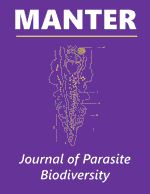Parasitology, Harold W. Manter Laboratory of

MANTER: Journal of Parasite Biodiversity
ORCID IDs
Date of this Version
12-5-2023
Document Type
Article
Citation
MANTER: Journal of Parasite Biodiversity (December 5, 2023) number 34
doi: 10.32873/unl.dc.manter34
LSID urn:zoobank.org:act:BCBF9CAD-D97A-41C1-AA41-7EB65603FA8C
LSID urn:lsid:zoobank.org:pub:0768AC62-B4C1-4737-8113-6DB413A241BE
Abstract
In the biosphere, limits for diversity among species, communities, and biomes are revealed through intensive and extensive field-based inventory and assembly of voucher specimens and associated informatics examined in a phylogenetic, historical, ecological, and biogeographic arena. Archival resources for specimens and information contribute to a cumulative view of faunal structure and assembly under a comparative umbrella. Ultimately, species definitions, and inclusive partitions among populations and lineages, are fundamental in articulating hypotheses that examine interactions about evolution, the nature of organisms, and the condition of environments across space and time. We conclude our proposals establishing species limits for tapeworms of the cryptic complex historically accommodated in Tetrabothrius jagerskioeldi Nybelin, 1916 among Alcidae seabirds (Charadriiformes). Explorations of this facet of marine diversity summarize inventory data for species of Tetrabothrius Rudolphi, 1819 from field collections among 1,976 seabirds of 41 species representing 3 avian orders (Charadriiformes, Suliformes, Procellariiformes) examined across 58 oceanic/geographic localities from the greater North Pacific basin between 1949 and 2019, or over the past 70 years. Cestodes of the complex including T. jagerskioeldi sensu stricto, T. alcae Hoberg and Soudachanh, 2021, and T. sinistralis Hoberg and Soudachanh, 2021, along with 2 previously unrecognized taxa, are documented, occurring in 128 of 1976 seabirds examined (6%) and 17 of 41 marine avian species from 23 insular, coastal, and pelagic sites spanning the North Pacific. In completing an evaluation of this assemblage, we focus on those cestodes among 8 species of medium- to small-bodied alcids, subfamily Fraterculinae. Specimens designated as Tetrabothrius fraterculus n. sp. were observed among puffins (2 species of Fraterculus and Cerorhinca), whereas Tetrabothrius aithuia n. sp. is proposed for tapeworms in auklets (4 species of Aethia and Ptychoramphus) and a puffin (Cerorhinca); both cestodes are currently unknown among the Alcinae species of Cepphus, Uria, Brachyramphus, and Synthliboramphus based on the North Pacific inventory collections. These large-bodied cestodes, typical of the 5 species in the complex, are characterized among 46 currently valid species of Tetrabothrius in avian hosts, based on unique configurations of the genital atrium; male and female genital papillae; terminal genital ducts; numbers of testes; and the structure, position, and dimensions of the vaginal and atrial seminal receptacles. Ancillary characters contributing to differentiation include attributes of the scolex, structure, dimensions, and position of the vitelline gland and relative position of the dorsal and ventral osmoregulatory canals. A suite of complex attributes unequivocally separates 5 respective species that had historically been relegated to a single geographically widespread and morphologically variable taxon under T. jagerskioeldi sensu lato. Host range for respective cryptic species of the T. jagerskioeldi–complex reveal an intricate view of ecological isolation and connectivity across the greater North Pacific basin. Seabirds, marine mammals, and parasites are indicators of changing conditions over space and time. Oceanic regime shifts, prey cascades, and diversity for birds and parasites serve as proxies for revealing accelerating perturbation in marine foodwebs under climate forcing.
Supplementary Table 2.pdf (181 kB)
Hoberg et al Resolution Tetrabothrius 2023 SUPP DATA TABLE 3.pdf (143 kB)
PDF version
Hoberg et al Resolution Tetrabothrius 2023 SUPP DATA TABLE 4.pdf (123 kB)
PDF version
Hoberg et al Resolution Tetrabothrius 2023 SUPP DATA TABLE 5.pdf (103 kB)
PDF version
Hoberg et al Resolution Tetrabothrius 2023 SUPP DATA TABLE 3.xlsx (43 kB)
Excel version
Hoberg et al Resolution Tetrabothrius 2023 SUPP DATA TABLE 4.xlsx (24 kB)
Excel version
Hoberg et al Resolution Tetrabothrius 2023 SUPP DATA TABLE 5.xlsx (22 kB)
Excel version


Comments
Copyright © 2023, Hoberg, Soudachanh, and Bondarenko
License: CC BY-NC-SA 4.0 International